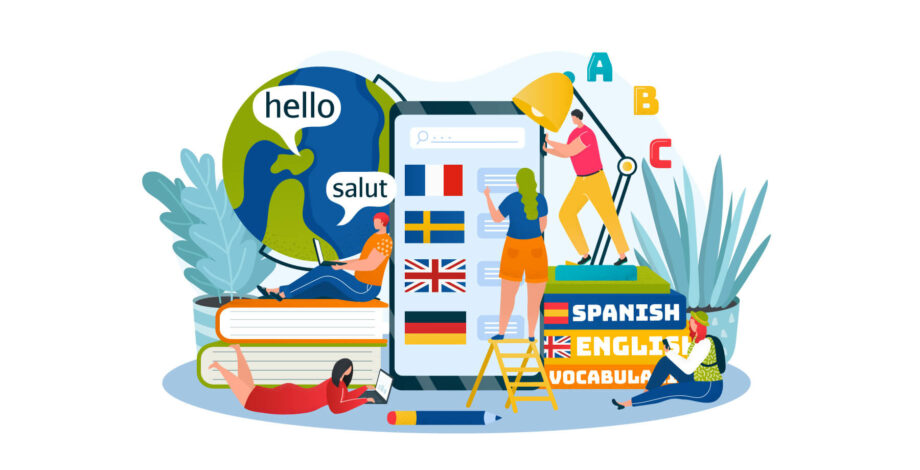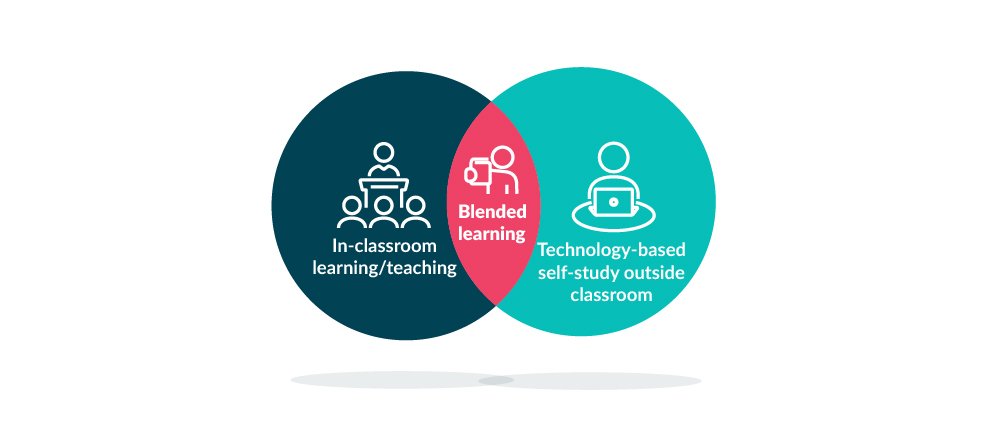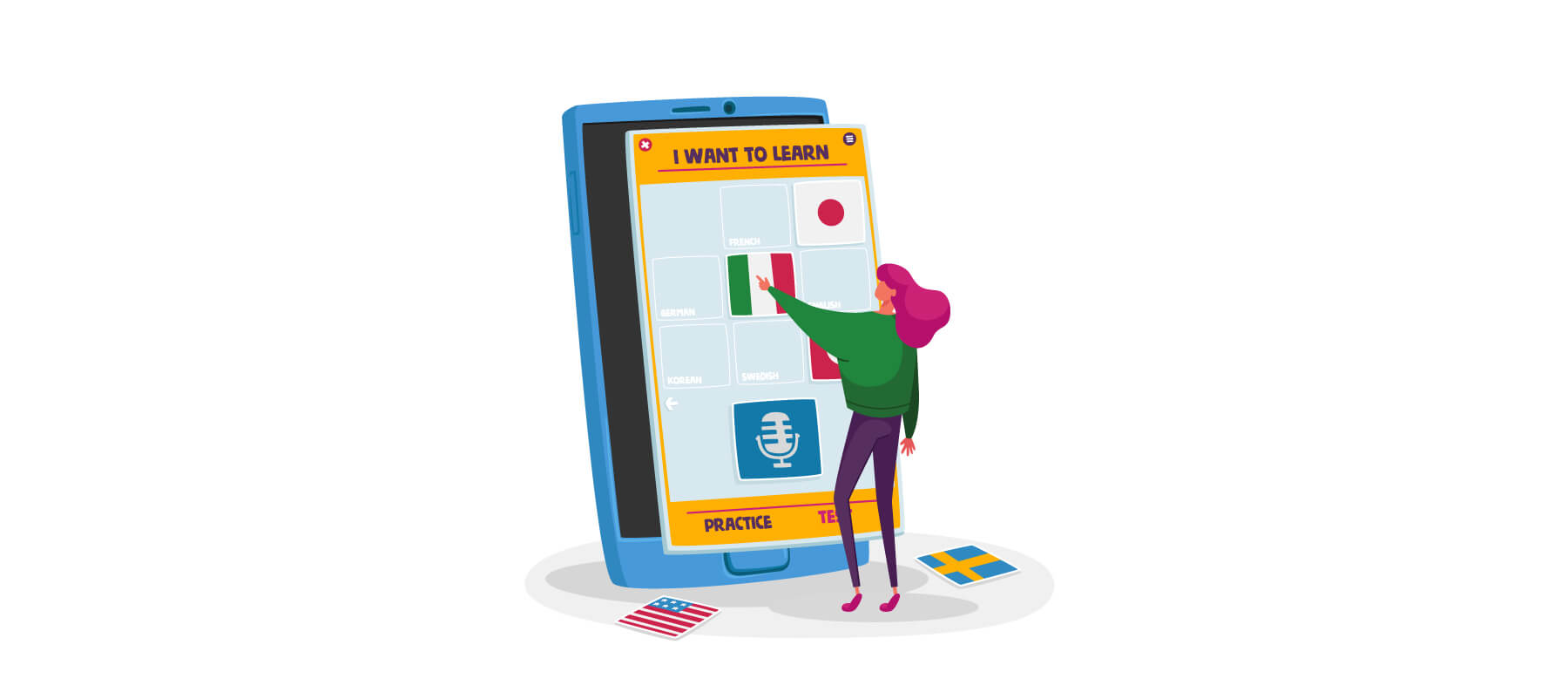Blended learning for languages can boost student engagement

It’s said that it takes around 500 hours to get to a basic level of fluency in a new language. If you studied for an hour a day, that’s still nearly two years. On a weekly language course, it could be years before you gain proficiency. This is where blended learning comes in. Combining traditional teaching with the use of technology helps to boost the language learning process.

Blended Learning Diagram
Blended Learning: What Is It?
As the name suggests, blended learning blends different learning methods. Essentially, blended learning combines traditional in-classroom teaching/learning with technology-based self-study outside of the classroom.
The second part of the blended learning approach, the technology-based e-learning component, can offer real support for language learning. The internet has a wealth of resources, from podcasts to videos, online grammar explanations to quizzes. Apps can also support learning, especially with the crucial but often tedious aspect of learning new vocabulary. When put together well by a tutor, these technology-based resources can significantly boost language acquisition.
During the recent lockdowns, in-classroom teaching switched to virtual classrooms, but teaching remained essentially the same. However, poor connectivity, poor sound and a lack of interactivity meant that the virtual classroom was not such an easy place to learn. This made the e-learning component even more important.
Blended Learning: Benefits for Learners?
For learners, there are many benefits to this blended approach.
We all learn in different ways. Some of us are visual or aural learners, which means learning happens best when combined with images or sound, like a video or a podcast. Others are verbal learners, who need to use the language in order to learn it – by reading aloud or taking part in prepared dialogues. Others like to use their logic to work out grammatical patterns.
All these learning styles can be accounted for when developing an e-learning course. When working independently, learners can choose what method suits them or use a combination of different methods to support different areas of language learning.
Videos are a fantastic way of learning a language and can be used to explore a range of real-life contexts. Not only can they help learners understand how language is used, videos help students develop a greater cultural understanding of the countries where the language is spoken. This can also expose learners to different accents, something one teacher on their own isn’t able to do.
Blended Learning: Benefits for Tutors?
By setting activities like quizzes, teachers can monitor student progress and send feedback tailored to the student. This also enables teachers to spot learners who may need extra support and point them to the activities and resources that will help them.
Through student feedback and usage analytics, tutors can also see how well students are engaging with the content. This can highlight activities that are popular and those that aren’t, which helps with the planning of upcoming content.
Blended Learning: Improved Learning?
How many of us remember trying to learn vocabulary lists for school? As dull as it can be, learning vocab is a vital part of boosting fluency. Do you remember how you learned the vocabulary? Did you write and rewrite the lists? Did you use colours to help remember the words or their genders? Or did you chant them or create a song or rhythm?
By using a mix of different media and methods, language teachers can boost learning and support their learners further. Flashcards, songs, videos, quizzes and games can all be used to take the drudgery out of language learning.
Flipped Learning
Blended learning turns the “traditional” education model of classroom teaching on its head. Flipped learning involves self-study before the classroom session. The session can then be spent exploring the topic in more detail. Not only does this give students more control over their learning, it means students engage in greater depth with the subject.
Using flipped learning, learners can practise in advance and take as much (or as little) time as they need to master the vocabulary, grammar and phrases for the next classroom-based session. This can help learners overcome any nervousness about using new phrases and terms in front of others.
It can also improve the quality of the learning. Learners can take their time reading a new text to develop greater understanding. The self-study may involve listening to a podcast or watching a video clip. Learners can listen or watch repeatedly, pausing if necessary. Besides improving their understanding, this will boost their confidence in the upcoming classroom session.
By introducing flipped learning for languages, the classroom (real or virtual) can take on a completely different structure. Instead of teaching the content, the lesson can focus on practising and polishing. Students can use new words and phrases in a more authentic way by developing scenarios that focus on speaking the new language as much as possible. Material can be worked through more quickly and a large group can be broken into pairs or smaller groups for conversational practice.

Blended Learning: Greater Learner Engagement
Blended learning increases student engagement in a number of ways.
It empowers students to become independent learners. They can study at a time that suits them best and in a way that they prefer, whether that’s during a daily commute or just before bed. Learners can choose what they enjoy doing, which in turn helps them feel more engaged with the course.
Another way of boosting learner engagement is gamification. The incorporation of quizzes, games and even interactive videos into the e-learning component can boost retention and recall and add an extra level of engagement. Students are no longer passively absorbing information; they are applying their knowledge to earn points, progress levels or compete against others. This creates a more enjoyable learning experience, which in turn ensures that the learning continues.

Language Learning with Ryze
Using Ryze can help boost language learning.
Studious has teamed up with La Dante to provide e-learning support for its Spanish and Italian courses. The app provides opportunities to incorporate grammar teaching, quizzes, and videos. La Dante understands the benefits of using different media in their language classes. They create fortnightly podcasts in English, Spanish and Italian for their learners. With the Ryze app, they can now offer their e-learning content in an organised and interactive way.
Students access the learning via our Ryze app – available on the Google Play and App Store and via the web. Ryze brings learning to life by combining academic content with bite-sized lessons, multimedia, quizzes, gamification, progress tracking, and personalisation. With our granular analytics you can see and download detailed breakdowns of how and when your students learn.
If you’re interested in developing your language courses using the Ryze app, please contact us here or at [email protected].
Other articles

13th Sep, 2021
ESTU + Studious - new partnership!
We are delighted to announce Estu+Studious: a new partnership with ESTU as part of our new corporate services development. Working with Simon Littlewood and Karl Eddy of Estu, Studious will deliver tailored learning solutions available for use in Apprenticeship Levy schemes to major corporations. The content delivered by Studious will be suitable for Learning […]

4th Aug, 2021
Tone of voice: what is yours?
How to use the top brands’ comms tactic to engage students with your online educational content Fast forward to September 2021: after weeks spent preparing classes, creating activities, developing quizzes and choosing case studies, you still have more videos and microphones turned off during your online lecture than you would like. How can […]

8th Jul, 2021
Achieving Wellbeing in the Workplace
It is said that a happy worker is a productive worker. Although organisations may have long realised the benefits of a happy and engaged workforce, it is only recently that we are beginning to understand the extent to which an employer can actively improve the wellbeing of its employees. In the workplace, employee wellbeing is […]

